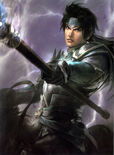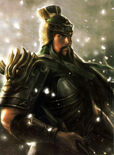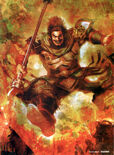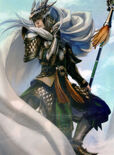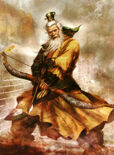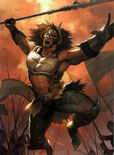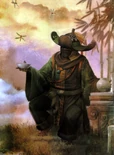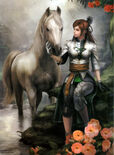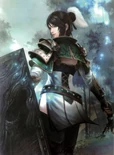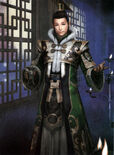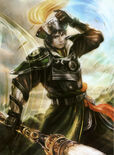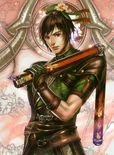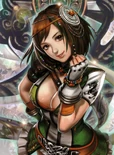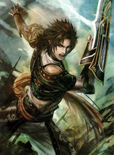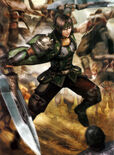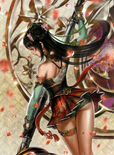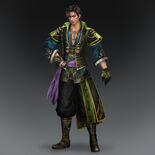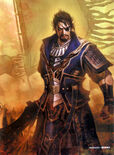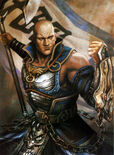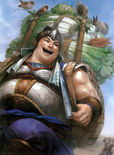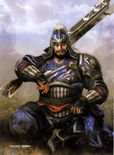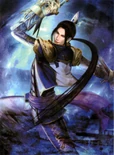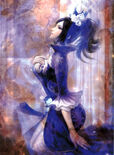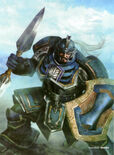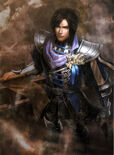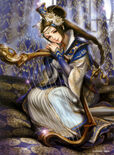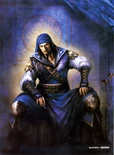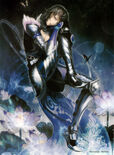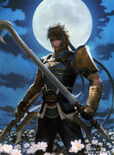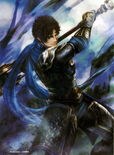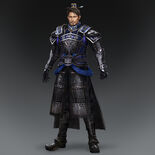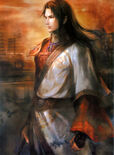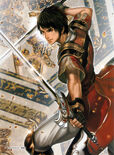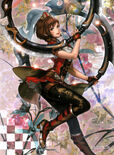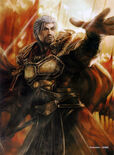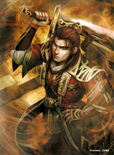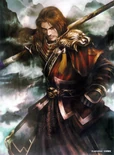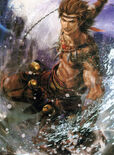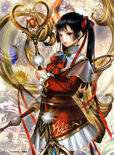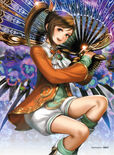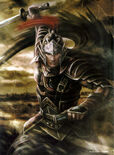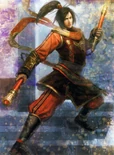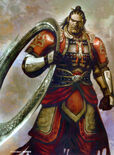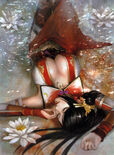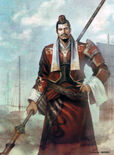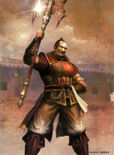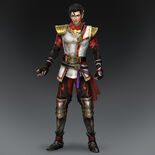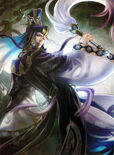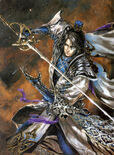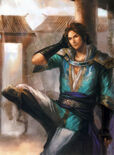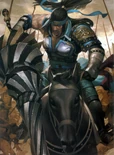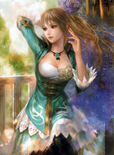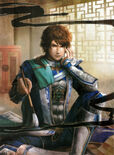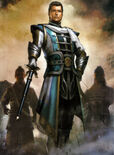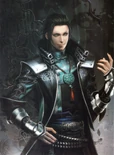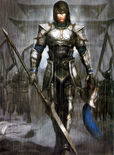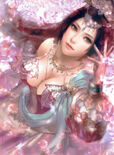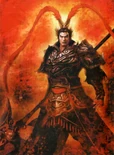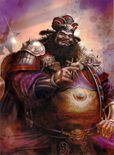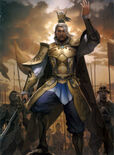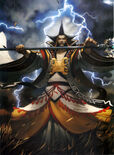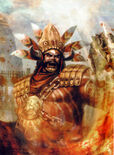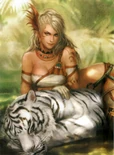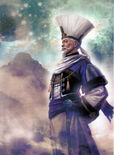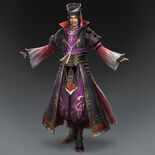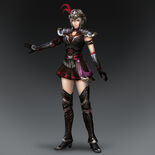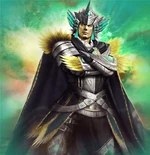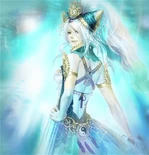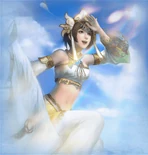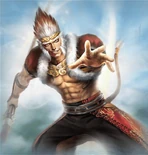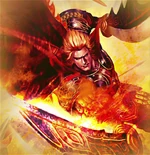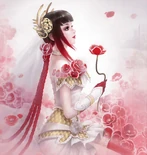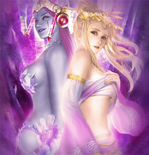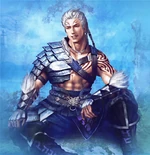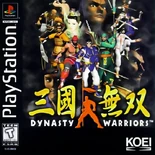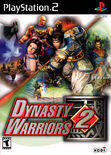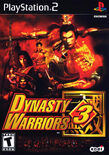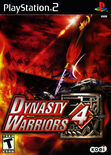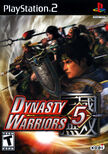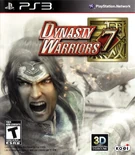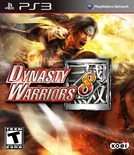Dynasty Warriors (三國無双, Sangoku Musou or 真・三國無双, Shin Sangoku Musou) is a series of Hack-n-slash action games started by Koei and created by Omega Force. It draws inspiration from the historical novel, Romance of the Three Kingdoms, entailing the epic struggle of power between three kingdoms in ancient China.
The series originally started as a 3D fighting game adaptation of the Romance of the Three Kingdom strategy series. When the developers wanted to port the fighting game to the PlayStation 2, they had second thoughts due to the fighting game boom at the time. To make themselves stand out, they envisioned a battlefield scenario and focused on the prospect of the player working with a team to fight against several opponents at once. After they decided to incorporate more elements from the Three Kingdoms era, it eventually became the hack-and-slash hit that it's known for today. To establish a distinct difference between the first release of the series, the word "true" (真, shin) was inserted for the second title. Hence, the Japanese title for Dynasty Warriors 3 is actually Shin Sangoku Musou 2 and so on.
Though listed under the action game genre, creators strove to make the series a "fusion of real time strategy and action". Eventually, the series's appeal was allowing the player to be a "one man army" versus the thousands of enemies in ancient China. Kou Shibusawa states that it was his personal desire to capture the excitement and thrill felt by the events in the novel. The series started its own type of genre. In the east, games similar to it are referred to as the Musou franchise. The English equivalent for the same term is Warriors series. Keeping in touch with the core ideas of its fighting game counterpart, the Dynasty Warriors series is designed to always be inviting to beginners to either the series or the action genre. The new features that are added into the series strive to never be too complicated, hoping to add another entertaining aspect for every type of fan of the Warriors games.
A recent Dengeki PlayStation interview reveals that the development team look at other Three Kingdoms period media frequently in between designing each entry. They also don't have a formal team of historical researchers like the ones seen in Koei's historical simulation titles. However, developers do rely on other novels, books and movies they have personally read or seen. A particular individual in the Omega Force team also knows the time era "by the back of their hand". Whenever they ask the person questions, he/she can correctly identify a particular place, person, or battle on the spot.
According to comments from Koei-Tecmo's CFO, Kenjiro Asano, the current Warriors engine is "dated" when compared to the fine details found in most first person shooters in today's market. He hinted that developers are devising a new engine to keep up with the ultra-realistic capabilities of the PlayStation 4.
The mechanics set in this series help influence game play elements in Koei's other titles, some of which include the Samurai Warriors and Dynasty Warriors: Gundam series, Kessen III, and Bladestorm: The Hundred Years' War. Both the Dynasty Warriors and Samurai Warriors series crossover in the Warriors Orochi series.
Characters
The three kingdoms struggling in each game are Wei, Wu, and Shu but the series also adds characters from miscellaneous, unaffiliated factions into the mix. These characters are labeled as "Other". Lastly, guest characters were added in the original Dynasty Warriors, and Dynasty Warriors 3. Dynasty Warriors: Strikeforce 2 includes several characters who didn't exist during the Three Kingdoms period. Dynasty Warriors 7 adds Jin to the games.
Characters are color coded by default to match the particular faction they serve. When told by a fan that the idea should be abandoned and to be more liberal like Samurai Warriors, the series producer defended the color choices since they serve as an easy method for distinguishing characters and their alignments. He would rather these tints serve as a political symbol of sorts than a completely driven aesthetic choice.
Shu
Wei
Wu
Jin
Other
Guest Characters
- Nobunaga (Dynasty Warriors)
- Tokichi (Dynasty Warriors)
- Samurai Warriors cast (Dynasty Warriors PSP)
- Samurai Warriors 2 cast (Dynasty Warriors Vol. 2)
- Orochi (Dynasty Warriors: Strikeforce)
- Da Ji (Dynasty Warriors: Strikeforce)
- Kiyomori Taira (Dynasty Warriors: Strikeforce)
- Taigong Wang (Dynasty Warriors: Strikeforce)
- Ryu Hayabusa (Dynasty Warriors: Strikeforce)
- Ayane (Dynasty Warriors: Strikeforce)
- Momiji (Dynasty Warriors: Strikeforce)
- Ayane (Dynasty Warriors VS)
- Ryu Hayabusa (Dynasty Warriors VS)
- Yukimura Sanada (Dynasty Warriors VS)
- Mitsunari Ishida (Dynasty Warriors VS)
- Kanetsugu Naoe (Dynasty Warriors VS)
Unique Non-Playable Characters
This list of characters refers to uniquely designed non-playable characters in the series.
- Sima Hui (Dynasty Warriors 5)
- Emperor Xian (Dynasty Warriors 6)
- Shi Huangdi (Shin Sangoku Musou Multi Raid 2)
- Sima Yan (Dynasty Warriors 7)
- Cao Mao (Dynasty Warriors 7)
- Huche'er (Dynasty Warriors 7)
- Wu Tugu (Dynasty Warriors 8)
- Cao Wenming (Dynasty Warriors Online)
- Xiahou Bang (Dynasty Warriors Online)
- Sima Ken (Dynasty Warriors Online)
- Simaji (Shin Sangoku Musou Online Z)
Games
- Dynasty Warriors
- Dynasty Warriors 2
- Dynasty Warriors 3
- Dynasty Warriors 3: Xtreme Legends
- Dynasty Warriors 4
- Dynasty Warriors 4: Xtreme Legends
- Dynasty Warriors 4: Empires
- Dynasty Warriors (PSP)
- Dynasty Warriors 5
- Dynasty Warriors Advance
- Dynasty Warriors 5: Xtreme Legends
- Dynasty Warriors 5: Empires
- Dynasty Warriors Vol. 2
- Dynasty Warriors Mahjong
- Dynasty Warriors DS: Fighter's Battle
- Dynasty Warriors Online (BB)
- Dynasty Warriors 6
- Dynasty Warriors 6: Special
- Dynasty Warriors: Strikeforce
- Dynasty Warriors 6: Empires
- Shin Sangoku Musou Multi Raid 2
- Dynasty Warriors 7
- Dynasty Warriors 7: Special
- Dynasty Warriors 7: Xtreme Legends
- Dynasty Warriors Next
- Shin Sangoku Musou VS
- Dynasty Warriors 7: Empires
- Dynasty Warriors 8
- Dynasty Warriors 8: Xtreme Legends
- Hyakuman-nin no Shin Sangoku Musou by GREE
- Shin Sangoku Musou SLASH by GREE
- Pachislot Shin Sangoku Musou by Fields
- Shin Sangoku Musou by Heiwa
- CR Shin Sangoku Musou by SanThree
- CR Shin Sangoku Musou Moushouden by SanThree
Related Merchandise
Koei published a twelve volume fanbook series titled Dynasty Warriors Communication (真・三國無双通信, Shin Sangoku Musou Tsushin). It contained information about the developers, gag comics, official illustrations, and fun tidbits for fans. When Samurai Warriors came out, the two franchises shared a similar publication titled Musou Fan Field (無双FanField). A miniature novel series for the Romance of the Three Kingdoms was also included. Two drama CDs based on Dynasty Warriors 4 were made surrounding the battles at Chi Bi and He Fei.
Gamecity also published a light novel dramatizing the CD's events. A free sample of the light novel can be read in Japanese here.
To celebrate their series's tenth anniversary, a cohesive character illustration book was released to include all characters and their iterations within this series. It states to include up until the sixth title, but the Strikeforce characters are also included in the book. Kabaya published trading cards with character illustrations found throughout the series.
A Dynasty Warriors themed PSP protective pouch was also created by Koei in 2006.
See also
Downloadable content for these games can be found in the DLC category.
External Links
- Koei-Tecmo's series 10th Anniversary site
- Japanese Playstation interview with an Omega Force founder and developer Kenichi Ogasawara

